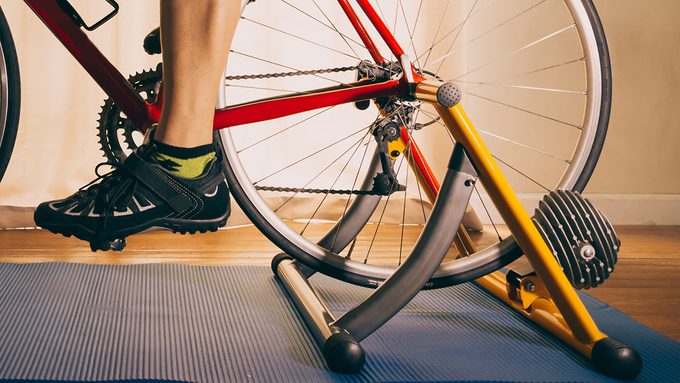Cycling Training – This Ain’t Your Typical Spin Class
If you’re training for a serious road biking event, then you should consider cycling classes. Here’s what you can expect.

I love spinning. Like really love it. So, when Ride For Karen asked me to train to participate in the 100K event, I thought, “How fun! Spin classes will be my excuse to train.”
I was wrong.
When I first arrive to meet with Steve Neal and Andrew Randell of The Cycling Gym in Toronto, I’m struck by how much the space looks like a Crossfit gym, and not so much like a slick SoulCycle class, with its exposed ceiling and cement walls.
My first session is a fit test, Randell (a former professional cyclist) tells me. He turns on the TVs on the wall in front of me to show the intensity of the climb intervals and explains the numbers I’ll be watching for: HR (heart rate), Max HR (maximum heart rate), CAD (cadence – the number of rotations of the pedal per minute, aka RPM) and Watts (energy expenditure).
As I’m told to bike to get certain numbers for the above, I half-jokingly say to Neal, “This is nothing like spin class.” And as a cycling coach of elite-level athletes, he laughs and says, “No, it’s not.”
Here are five other ways a cycling training class is not like spin class and what you can expect from your first time training.
1. You don’t adjust your bike.
That’s because you bring your own bike and (hopefully) it’s adjusted to your body when you bought it. Instead of adjusting your bike, you load it on the “trainer,” a bike stand with a motor that will measure and challenge you through the class.
2. You don’t have the option of not going on the leader board.
Not all spin classes have a leader board at the front, showing the rest of the class how well you’re performing in class. And those that do often will let you opt out of your name and numbers on display. But not in a cycling class. That’s because your instructor uses these numbers to give you feedback and customizes your workout accordingly. HR too high? CAD too low? You’ll get instructions on how to fix that.
3. It’s not about the music.
As a cue to how fast you should be pedalling, spin classes use upbeat music (often pop music with 120 to 140 beats per minute) to keep your feet moving. And the intervals of a workout are framed around a song’s structure, with the chorus being the most intense. In a cycling class, the intensity is based on what an outdoor ride would be like. And while music might be playing, you don’t have to pedal to the beat. And that does take some adjusting for the mind-body connection.
4. Your heart rate matters.
Spin classes might use your heart rate to more accurately guess how many calories you’re burning, but in a cycling class, the heart rate is more of an indicator of your endurance level. “I’m not here to tire you out like a spin class would,” says Neal. “I’m here to make sure you can last on long rides.”
5. You don’t adjust the resistance.
In a spin class, you might get told to turn the resistance nob so many times to increase the tension, but in this class, it’s much more like outdoor cycling. You know that that hill is coming up, and you feel like creep up under your feet.
But one thing is for sure: Both are killer workouts. And while I don’t feel as exhausted after the cycling workouts, which tend to go for about 90 minutes, I know I’ve worked out just as hard and harder than in spin class. I see it on my reports, with the distance, HR and calories burned.




